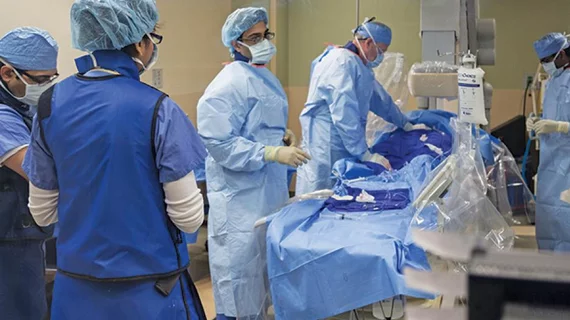ACO participation doesn’t change use of coronary revascularization
Providers were just as likely to perform low-value coronary revascularizations after joining an accountable care organization (ACO), a new analysis found.
Considering ACOs are designed to curb healthcare spending, these findings suggest their current setup doesn’t properly incentivize specialists to change their behavior, senior author Andrew M. Ryan, PhD, and colleagues wrote in Circulation: Cardiovascular Quality and Outcomes.
They looked at a random sample containing 20 percent of Medicare beneficiaries and matched them to provider groups, then used an ACO database to determine if the providers participated in an ACO. A coronary revascularization was considered low-value if it was performed in a patient with stable ischemic heart disease without a history of congestive heart failure or a recent admission for acute myocardial infarction (AMI). High-value procedures included patients with recent AMI.
“For both low- and high-value scenarios, we found that rates of change for total coronary revascularization, coronary artery bypass grafting, and PCI (percutaneous coronary intervention) among beneficiaries treated by provider groups participating in a Medicare ACO contract were similar to those of beneficiaries treated by nonparticipating groups,” wrote Ryan, with the University of Michigan School of Public Health, and coauthors. “These findings indicate that the incentives of Medicare Shared Savings Program and Pioneer may be too weak to limit the growth in spending on cardiac specialty care, and that refinements of current alternative payment models and risk-bearing contracts are needed to influence provider behavior.”
Most providers in the study participated in “one-sided” risk models, the authors noted—something CMS Administrator Seema Verma, MPH, recently hinted could be targeted by regulations. She said at the American Hospital Association’s annual meeting in May that ACOs which have taken on downside risk have produced better results.
Ryan and coauthors said specialists in the one-sided risk models may “have too little skin in the game” to change their practice patterns.
“Half of Medicare ACOs have no formal arrangements with specialty practices,” they noted. “Given that ACO primary care physicians, by law, cannot restrict their beneficiaries’ care choices, weakly connected specialists may fall outside the reach of ACOs.”
There were also relatively low rates of revascularization for low-value cases across the board, which may have limited the ability to detect differences before and after ACO participation. Participating and nonparticipating provider groups both performed these procedures in about 1 percent of beneficiaries meeting this criteria throughout the study period. Recent AMI patients—or high-value cases—received CABG or PCI at rates of 51.5 percent in 2008 and 58.5 percent in 2014.
The authors pointed out they didn’t have specific information on patients’ symptom burden so they couldn’t comment on the appropriateness of the intervention—just whether it was deemed high- or low-value by their definition. They added findings may not be generalizable to low-value care for other conditions, but maintain it’s a topic worth examining as ACOs seek to limit unnecessary healthcare spending.
“The focus of the initial iteration of Medicare ACOs has been on enhanced primary care for beneficiaries with multiple chronic medical conditions and complex medical needs,” Ryan et al. wrote. “This narrow focus has produced, at best, slight savings for Medicare. As suggested by our exploratory analysis, new more comprehensive designs that better incorporate specialists may be necessary if ACOs are to reach their full potential. Without such changes, the current Medicare ACO programs may struggle to control specialist costs.”

